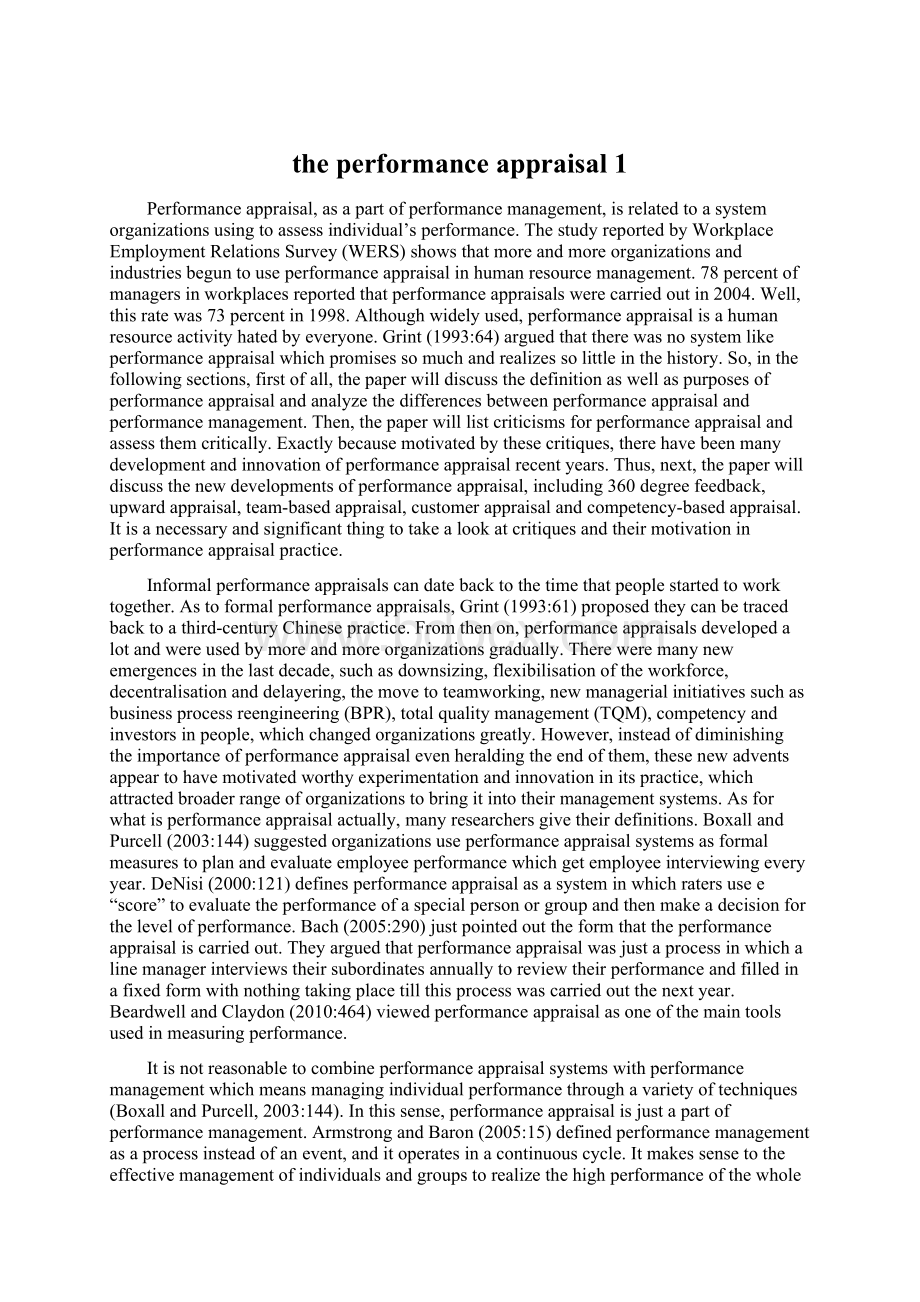the performance appraisal 1.docx
《the performance appraisal 1.docx》由会员分享,可在线阅读,更多相关《the performance appraisal 1.docx(7页珍藏版)》请在冰豆网上搜索。

theperformanceappraisal1
Performanceappraisal,asapartofperformancemanagement,isrelatedtoasystemorganizationsusingtoassessindividual’sperformance.ThestudyreportedbyWorkplaceEmploymentRelationsSurvey(WERS)showsthatmoreandmoreorganizationsandindustriesbeguntouseperformanceappraisalinhumanresourcemanagement.78percentofmanagersinworkplacesreportedthatperformanceappraisalswerecarriedoutin2004.Well,thisratewas73percentin1998.Althoughwidelyused,performanceappraisalisahumanresourceactivityhatedbyeveryone.Grint(1993:
64)arguedthattherewasnosystemlikeperformanceappraisalwhichpromisessomuchandrealizessolittleinthehistory.So,inthefollowingsections,firstofall,thepaperwilldiscussthedefinitionaswellaspurposesofperformanceappraisalandanalyzethedifferencesbetweenperformanceappraisalandperformancemanagement.Then,thepaperwilllistcriticismsforperformanceappraisalandassessthemcritically.Exactlybecausemotivatedbythesecritiques,therehavebeenmanydevelopmentandinnovationofperformanceappraisalrecentyears.Thus,next,thepaperwilldiscussthenewdevelopmentsofperformanceappraisal,including360degreefeedback,upwardappraisal,team-basedappraisal,customerappraisalandcompetency-basedappraisal.Itisanecessaryandsignificantthingtotakealookatcritiquesandtheirmotivationinperformanceappraisalpractice.
Informalperformanceappraisalscandatebacktothetimethatpeoplestartedtoworktogether.Astoformalperformanceappraisals,Grint(1993:
61)proposedtheycanbetracedbacktoathird-centuryChinesepractice.Fromthenon,performanceappraisalsdevelopedalotandwereusedbymoreandmoreorganizationsgradually.Thereweremanynewemergencesinthelastdecade,suchasdownsizing,flexibilisationoftheworkforce,decentralisationanddelayering,themovetoteamworking,newmanagerialinitiativessuchasbusinessprocessreengineering(BPR),totalqualitymanagement(TQM),competencyandinvestorsinpeople,whichchangedorganizationsgreatly.However,insteadofdiminishingtheimportanceofperformanceappraisalevenheraldingtheendofthem,thesenewadventsappeartohavemotivatedworthyexperimentationandinnovationinitspractice,whichattractedbroaderrangeoforganizationstobringitintotheirmanagementsystems.Asforwhatisperformanceappraisalactually,manyresearchersgivetheirdefinitions.BoxallandPurcell(2003:
144)suggestedorganizationsuseperformanceappraisalsystemsasformalmeasurestoplanandevaluateemployeeperformancewhichgetemployeeinterviewingeveryyear.DeNisi(2000:
121)definesperformanceappraisalasasysteminwhichratersusee“score”toevaluatetheperformanceofaspecialpersonorgroupandthenmakeadecisionforthelevelofperformance.Bach(2005:
290)justpointedouttheformthattheperformanceappraisaliscarriedout.Theyarguedthatperformanceappraisalwasjustaprocessinwhichalinemanagerinterviewstheirsubordinatesannuallytoreviewtheirperformanceandfilledinafixedformwithnothingtakingplacetillthisprocesswascarriedoutthenextyear.BeardwellandClaydon(2010:
464)viewedperformanceappraisalasoneofthemaintoolsusedinmeasuringperformance.
Itisnotreasonabletocombineperformanceappraisalsystemswithperformancemanagementwhichmeansmanagingindividualperformancethroughavarietyoftechniques(BoxallandPurcell,2003:
144).Inthissense,performanceappraisalisjustapartofperformancemanagement.ArmstrongandBaron(2005:
15)definedperformancemanagementasaprocessinsteadofanevent,anditoperatesinacontinuouscycle.Itmakessensetotheeffectivemanagementofindividualsandgroupstorealizethehighperformanceofthewholeorganization.LGMB(1994:
6)viewedperformancemanagementassystemsandattitudeswhichhelporganizationstoplan,delegateandassesstheoperationoftheirservices.Williams(1998:
221)pointedorganizationscanuseperformancemanagementtomanageorganizationperformanceoremployeeorbothofthem.Townley(1993:
223)suggestedthatappraisalplaystheroleoftechnologyintheconstitutionofmanaging.BoxallandPurcell(2003:
290)thoughtperformanceappraisalhasbecomemoreintegratedintosystemsofperformancemanagementwhichcandomorethingsforindividualsaswellastheorganizationstheyworkfor.Advocatesproposedthatthecycleofintegratedactivitiesofperformancemanagementgetthecontributionofindividualsandtheperformanceofthewholeorganizationtogether.However,theresultsofeachindividualappraisalarealwaysnotlinkedtocorporateobjectives.
AlthoughtheperformanceappraisalhasbeenpopularusedincompaniesintheUK,theUSAandtheothercountries,becomingthemostpopularandimportantpartofHRM,therearemanyproblemswithit.Inthissection,thepaperwilllistthemainorthodoxandradicalcritiquesofperformanceappraisalanddiscussthestudiesonthesetwotopicsfirstandthenmakeacriticalassessofthetwokindsofcritiquesindetailrespectively.
Therearetwomainorthodoxcritiquesofperformanceappraisal.Oneofthemainandwidelyidentifiedproblemsisthatorganizationsalwaysuseperformanceappraisalforalotofdifferentpurposes.Callahan(2007)suggeststhatperformancemeasurementisinadequateasitfailstorecognizethekeyconceptsofaccountabilityandcitizenparticipation.Furthermore,itfailstoidentifyandconcentrateonthecriticalimportanceoftheirrelationship.Thatistosayperformanceappraisalsarecompromisedbecausetheyareusedforavarietyofseenbeingconflictingpurposes.Inaddition,stakeholderswhoundertaketheperformanceappraisalsmayhavedifferentrolesandresponsibilitieswhichmaybeconflicting(Wilson,2002:
665).RedmanandWilkinson(2006:
157)proposedthatorganizationsuseperformanceappraisaltoidentifyanddefineperformanceexpectations,providecareercounsel,improveindividual,identifytraininganddevelopmentneeds,facilitatecommunicationsandinvolvement,assessteamandcorporateperformance,allocatefinancialrewards,determinepromotion,motivateandcontrolemployeesandachieveculturalchange.Theyfurtherarguedthatmanyoftheabovepurposesconflictwitheachother.Bach(2006:
297)pointedoutthatatfirst,organizationsuseperformanceappraisaltodeciderewardsofeachemployeeonthebasisofanevaluationofpastperformance.While,infact,theappraisalisusedtomotivatestafftoimproveperformanceaswellasidentifytrainingneeds.Somanypurposesforcetheappraisertoadoptconflictingroles.MurphyandMargulies(2004:
3)alsothoughtthatinthepractice,organizationsrequiretheirperformanceappraisalsystemtodotoomuch.Appraisalsareexpectedtofulfillmostevenallofthefollowingfunctions–feedback,goalsetting,coaching,paydetermination,skilldevelopment,employeecomparisonlegaldocumentationandlayoffselection.
Theotherwidelyarguedproblemisthatmanymanagersdoubtthevalidityofperformanceappraisal.Bach(2005:
303)arguedthatmanagersdon’ttrusttheirappraisalsystemsbecausetheexpectationofthesystemissohighwelltheoutcomesarealwaysdisappointing.BoxallandPurcell(2003:
145)pointedoutthattheproblemmustpayattentiontoisthatdisappointingoutcomesalwaysstandbythesideofgoodintentionsintheperformanceappraisalarea.
Itistruethattheorthodoxcritiquesofperformanceappraisalindeedpointoutsomeproblemsthatemergedintheprocessofperformanceappraisalimplementation.However,itdoesn’tanalyzeprimaryissuesrelatedtothehypothesisofperformanceappraisal(Bach,2005:
290).Problemsproposedbytheorthodoxcritiquescanberemediedthroughpropertrainingandcommunication.Theperformanceappraisalisundertakenbymanagerswhomaylackenoughknowledgeofinterview.Managerslackinterviewskills.Theyhavenoideasaboutusingwhatcriterionstoevaluateemployeeperformance.Sometimes,theymaymagnifyonemeritofparticularemployeewhileignoretheotherbenefitsandevenshortcomingsofthisperson.Sometimes,theymayevaluateemployeeperformancebasedontheirrecentbehaviorwhileignorethelong-termperformanceoftheemployees.Theymaydenyallperformanceoftheemployeebecauseofarecentmistake.Sometimes,theymayappraisestaffaccordingtotheirsubjectivefeelingsratherthananobjectiveevaluationoftheperformance.Sometimes,theymaynotwanttooffendanyemployeethusgiveallemployeessimilarscore.Allofthesecouldleadtoraterbias.Inaddition,becausethemanagersmayplaydifferentroles,theyhopetoachievemanypurposesthroughtheevaluation.Alloftheseareindeedimplementationproblemsexistingintheprocessofperformanceappraisalobjectivelywhichcanbeeasedoreveneliminatedthroughappropriatetrainingandcommunication.However,theorthodoxcriticismneglecttherootcausesoftheseimplementationissues.Iftheseproblemsaresolved,newproblemswillarise?
Performanceappraisalsystemisreasonable?
Theorthodoxcritiquesdon’ttakein-depthanalysisandreflection.However,theleadingcausesoftheseimplementationissuesaremostlikelyduetotheproblemsresideintheassumptionsofperformanceappraisal.Trainingandcommunicationcansolvesomeproblems,butitdoesn’tsolvealltheproblemsintheimplementationprocess.Newproblemswillariseagainandagain.Onlyaddressingtherootproblems,theimplementationproblemscanbeavoidedtotally.
Assumptionsaboutthepurposeofperformanceappraisalhavebeenquestionedincreasingly(Bach,2005:
290).Theradicalcritiquesmainlypayattentiontotheissuesofmanagementcontrolanditsusef